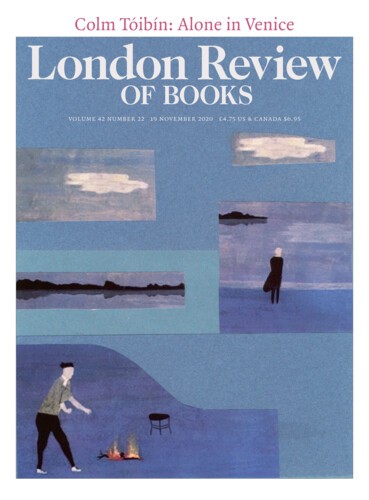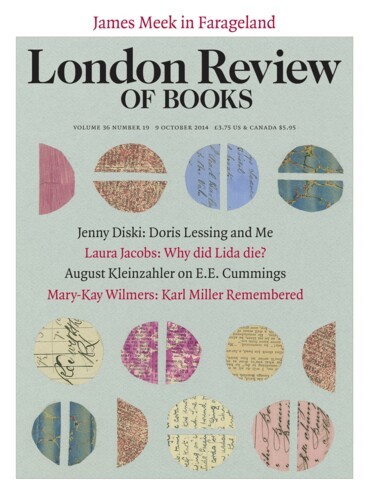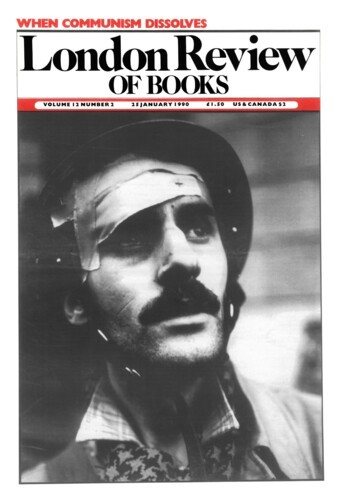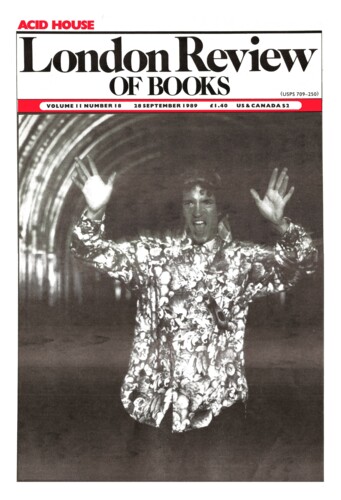Neil Corcoran
Neil Corcoran lectures in English at Sheffield University. His books include a study of David Jones and Seamus Heaney.
Correction
8 October 2014
Davie’s Rap
Neil Corcoran, 25 January 1990
One of the finest things in Donald Davie’s Under Briggflatts is a sustained, learned and densely implicative comparison of two poems about horses: Edwin Muir’s well-known, post-Apocalypse poem ‘The Horses’ and Austin Clarke’s much less familiar ‘Forget me not’, a poem written out of Clarke’s angry response to the Irish trade in horse meat in the 1950s. Although generously receptive to both, Davie comes out decisively in favour of the historical rootedness, specificity and consequent stylistic bristle and speed of the Clarke against the ahistorical, symbolist stasis of the Muir, identified as the mode of ‘mythopoeia’. As the argument develops, however, Davie reaches a startling conclusion: both poems are dependent on a conception of the ‘horse’, and therefore on a conception of ‘man’ (since the domesticated horse has significance only in relation to human beings), which share a ‘belief in the sacred’. Muir’s horses clearly represent the emergence of the possibility of some new post-holocaust inter-relationship between man and animal (and therefore suggest what an ideal present relationship might be); Clarke’s vituperative disgust with Irish mercenariness, and his elaborate poetic campaign of moral re-education, would be pointless if the horse were only a farmyard animal. Even though the poems are as far apart in tone as it is possible to conceive – the Muir all rapt and visionary, the Clarke sardonic and declamatory – both bear witness ‘that every poet’s task is ultimately and essentially religious; and that it is dangerous for any poet to think otherwise.’’
Reckless
28 September 1989
Neil Corcoran confronts the new recklessness
Neil Corcoran, 28 September 1989
For a writer who several years ago published a ‘Manifesto Against Manifestoes’, James Fenton has published his fair share of manifestoes, including a disguised one for a ‘Martian school’ to which he did not belong. The latest, ‘Manila Manifesto’, comes as part of a package with his new book Manila Envelope. To acquire the book, you must write to Manila, and it will be posted to you in a manila envelope stamped ‘Contents: Poetry’; the manifesto itself is printed on manila paper. This visual and verbal punning puts me in mind of Frank O’Connor’s account of a picture he saw in Joyce’s Paris flat: the city of Cork in a cork frame. An instance, no doubt, of Joyce’s compulsive punning, the picture can also be viewed as the manifestation of an ambiguous attitude. The visual pun depreciates the city of Joyce’s forebears, suggesting the voluntary exile’s self-justifying, cosmopolitan hauteur: but it also cherishes the place. James Fenton’s joky, vaguely self-indulgent punning on place, paper and title also indicates a more than merely joky intent. A manila envelope made in and posted from a Manila recently under the control of Marcos may contain an explosive device, particularly if the cover of the book it ostensibly contains has a savage Nicholas Garland illustration of a wild horseman wielding a bloody scimitar, surrounded by the decapitated victims of his havoc.
Pieces about Neil Corcoran in the LRB
Hand and Foot: Seamus Heaney
John Kerrigan, 27 May 1999
When Seamus Heaney left Belfast in 1972, to work as a freelance writer in the relative safety of the Republic, Northern Ireland was a war zone. Internment and Bloody Sunday had recruited so many...
Read anywhere with the London Review of Books app, available now from the App Store for Apple devices, Google Play for Android devices and Amazon for your Kindle Fire.
Sign up to our newsletter
For highlights from the latest issue, our archive and the blog, as well as news, events and exclusive promotions.




